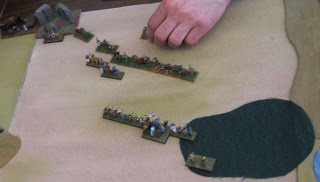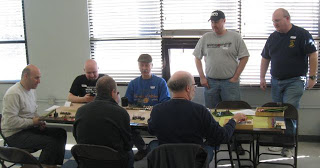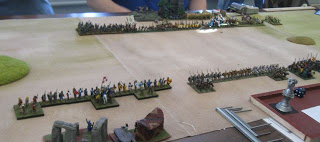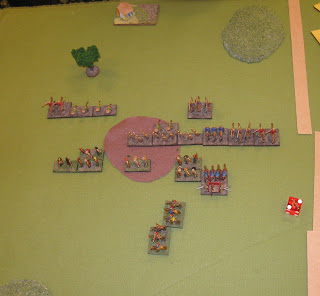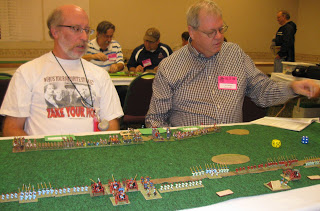I didn’t take enough notes to post details of everything I did at Cold Wars, so a summary post will have to do.
We stayed at the Lancaster Host again… that place is getting to be a bit of a dump. We got a pretty crummy room: it reeked of smoke and had clogged drains. Fortunately we really only slept there anyway so it wasn’t a big deal. On the other hand, food options are better than they used to be. There are burritos available for lunch, and the “family restaurant” next door turned into a Japanese/sushi restaurant. They also still have the nightly pig roast, if you’re into that sort of thing.
JM and I arrived a bit after 8pm on Thursday, so we probably could’ve played the Dismounting Knight event. Instead, we decided to get in some more games of Hordes of the Things, since we had hardly ever played and had an event on Saturday that sort of expected us to know most of the rules.
BBDBA Doubles
Friday’s main event was BBDBA Doubles. JM and I took Alexandrian Imperial (II/15) with a Mountain Indian Ally (II/2). This was supposed to give us good punch in Alex’s mounted wing, a defensive wall of pike, and lots of bad going troops in the ally. It’s a high aggression army, so we expected to attack every game, and weren’t disappointed. Although we considered many of the enemies we might face, some of our opponents gave us a bit of a surprise.
 |
| Stephen Aspenberg and Doug Austin |
In the first game, we faced Doug Austin and Stephen Aspenberg, playing Bosporans and Sarmatians. They had a lot of knights, with some light troops and artillery in the center. We deployed the mountain Indians on the far left flank to outflank them, and Alexander on our right. Unfortunately my Mountain Indians were crushed by playing with knights they should’ve stayed away from, and our pikes were too far off our right flank to be as useful as we would prefer. In the end, they beat us with two commands demoralized after taking 50% losses to the army; but our C-in-C command had no casualties; mostly because they took so long to get into contact with the enemy.
 |
| Alex and Jonathan Bostwick |
Next we faced the Bostwicks, who had a ton of cavalry with some light foot in the center. Since they didn’t have anything affected by double ranked pikes, we thinned out our line and faced them on a wide frontage. My Mountain Indians had relatively even odds against their Cavalry, but they were more able to take advantage of holes in our line, so my right flank was the first to fall. On the left, we fared much better: JM demoralized their C-in-C command. Unfortunately, we had more losses than they did, so we didn’t win outright. Instead, we lost the battle of attrition as they killed us faster than we could kill them.
I think our setup worked better in this game, and I’m not sure how we could’ve improved things very much from a strategic perspective. One possibility would’ve been to place our Mountain Indians in the center, and hope they responded by deploying their Cavalry opposite us. This would’ve been essentially the same matchups we had, except our pike would have been able to gang up on them… eventually, if they ever made it into contact with the enemy.
In the third round, the only teams we were likely to face were both from Pittsburgh and were both playing Ptolemaics. We ended up facing Larry and Rich instead of Tim and Lisa.
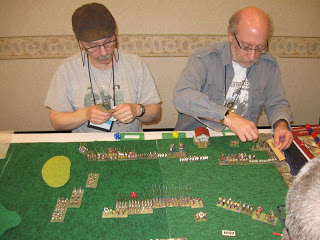 |
| The Stooges: Rich Baier and Larry Chaban |
Since Saturday’s campaign theme was a Successor event, we did a bit more thinking than average about how to face another Pike army. The biggest questions we had were: what do you do with the Mountain Indians, and how can you break their C-in-C command when it’s built entirely out of Pikes? Our typical strategy was to try to break the C-in-C command, but against pikes we might need to settle for killing everything else; but we needed to keep their pike at bay while we did it. The answer we came up with was to send the Mountain Indians against their pikes, while facing the rest of their army with our remaining two commands.
The Mountain Indians have 7 elements that can’t be harmed by pikes unless they step out of formation and make themselves vulnerable, so that’s relatively safe. Our light horse general can also quick kill their pikes relatively easily… in theory. We did relatively well, but our main mistake was to send too much of our pike against their pike instead of facing their lighter troops. Our other big mistake was thinking the center of their line was made up of auxilia, when it was in fact blades. They concentrated two commands against our C-in-C command, and crushed us relatively quickly.
Littoral Landing Lovers
After BBDBA Doubles was a themed event that only allowed Littoral armies. In the first round, I faced Larry and he finally got his payback against my as-yet-unbeaten Leidang (III/40d). This time, I took 1xKn, 5xBd, 3xAx, 1xPs, 1xSp, 1xBw. I did a landing and had some initial success, until he killed my bow with his knight and rolled me up.
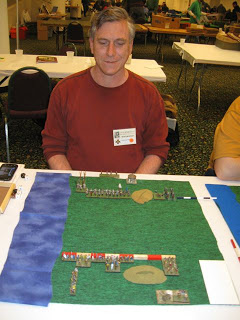 |
| Doug Mudd |
Next, I faced Doug Mudd. The game went so quickly, I don’t remember his army. He attacked, and did a landing behind my line. Using a first turn psiloi double move, he sent a psiloi against my Knight general, which turned to face. The combat was his 2 to my 4 with me quick killing him, but he rolled high and recoiled my general into my own troops, winning the game 1g-0 before I even had a turn. Oops! We had a lot of free time, considering some players weren’t even done deploying yet, so we played an unofficial rematch (shown here), and I beat him in this second game. I don’t think either of us did a landing.
 |
|
| Stephen Aspenberg |
In the final round, I faced Stephen Aspenberg’s Athenians. I decided that since this was a Littoral Landing event, I’d better do another landing. I sent 2 elements against his flank, and he sent 3 against mine. My elements were able to kill 2 of his, while I held off his landing with only 2 of mine. When we met in the middle, my blades beat his spears and I won.
This leaves my Leidang with a 7-2 record, which I’m only keeping track of because it’s one of the only armies I’ve managed to win consistently with.
Midnight Madness
I don’t remember a lot about Midnight Madness (and don’t have any pictures), but there wasn’t much to remember. In the first round, I played my Hittite Empire (I/24b) against Jonathan Bostwick’s Minoan & Mycenaean (I/18). I won, but that’s all I remember… though I have a feeling neither of us remembered to place our camp. In the second round, I faced Later Mycenaeans and Trojan War (I/26) and lost.


